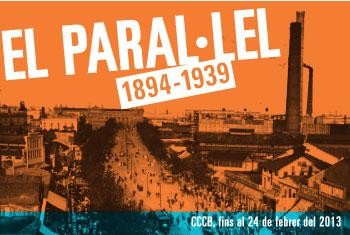Paral·lel Avenue, 1894-1939
26 Oct 2012 - 24 Feb 2013
PARAL•LEL AVENUE, 1894-1939
Barcelona and the Spectacle of Modernity
Curators: Xavier Albertí, Eduard Molner
26 October 2012 - 24 February 2013
El Paral·lel emerges from the project to extend the city designed by Ildefons Cerdà. From its birth, a series of contradictory urban planning regulations facilitated the appearance of ephemeral buildings and the conversion of this street into a dense area of leisure and entertainment.
The result was a leisure district for the masses, perfectly comparable to those existing in other major European urban agglomerations at that time, but that immediately became a genuine cultural expression of the social and political conflict that characterised the Barcelona of the early 20th century. El Paral·lel generated shows with perfectly differentiated contents and formats, made up by the audience and the artists.
This exhibition will explain, therefore, why a new entertainment area emerged in the city, leading the weight of the theatrical axis to move from the Plaça Catalunya-Passeig de Gràcia area to the Nou de la Rambla-Paral·lel area.
It will also explain how the new modalities of stage expression were configured based on two fundamental elements: the representation of ways of living in District V and of the social transformations and new value codes; and penetration by foreign popular stage genres and their “nationalisation” based on the demand from new audiences.
Moreover, El Paral·lel became the visible manifestation of a profound change in the social perception of sex. A change that would affect Catalan society across the board and had much to do with standards of tolerance towards the break away from traditional morals.
El Paral·lel was also the place where the ideologies that moved political and trade union organisations of the popular classes were made manifest. Republicans, socialists and anarchists were scattered around the city and often had meeting places at the theatres, where sometimes political rallies were held in the mornings and shows in the evening and at night.
Photography, the press and the visual arts in particular form the basis of the various sections of the exhibition. This area of the city has provided the inspiration for a long list of artists, including Picasso, Nonell, Francesc Domingo, Ricard Urgell, Ricard Canals, Ramon Casas, Rafael Barradas, Feliu Elias (“Apa”), Opisso, Emili Bosch Roger, Ismael Smith, Jaume Pasarell, Picabia and Gleizes.
Barcelona and the Spectacle of Modernity
Curators: Xavier Albertí, Eduard Molner
26 October 2012 - 24 February 2013
El Paral·lel emerges from the project to extend the city designed by Ildefons Cerdà. From its birth, a series of contradictory urban planning regulations facilitated the appearance of ephemeral buildings and the conversion of this street into a dense area of leisure and entertainment.
The result was a leisure district for the masses, perfectly comparable to those existing in other major European urban agglomerations at that time, but that immediately became a genuine cultural expression of the social and political conflict that characterised the Barcelona of the early 20th century. El Paral·lel generated shows with perfectly differentiated contents and formats, made up by the audience and the artists.
This exhibition will explain, therefore, why a new entertainment area emerged in the city, leading the weight of the theatrical axis to move from the Plaça Catalunya-Passeig de Gràcia area to the Nou de la Rambla-Paral·lel area.
It will also explain how the new modalities of stage expression were configured based on two fundamental elements: the representation of ways of living in District V and of the social transformations and new value codes; and penetration by foreign popular stage genres and their “nationalisation” based on the demand from new audiences.
Moreover, El Paral·lel became the visible manifestation of a profound change in the social perception of sex. A change that would affect Catalan society across the board and had much to do with standards of tolerance towards the break away from traditional morals.
El Paral·lel was also the place where the ideologies that moved political and trade union organisations of the popular classes were made manifest. Republicans, socialists and anarchists were scattered around the city and often had meeting places at the theatres, where sometimes political rallies were held in the mornings and shows in the evening and at night.
Photography, the press and the visual arts in particular form the basis of the various sections of the exhibition. This area of the city has provided the inspiration for a long list of artists, including Picasso, Nonell, Francesc Domingo, Ricard Urgell, Ricard Canals, Ramon Casas, Rafael Barradas, Feliu Elias (“Apa”), Opisso, Emili Bosch Roger, Ismael Smith, Jaume Pasarell, Picabia and Gleizes.

